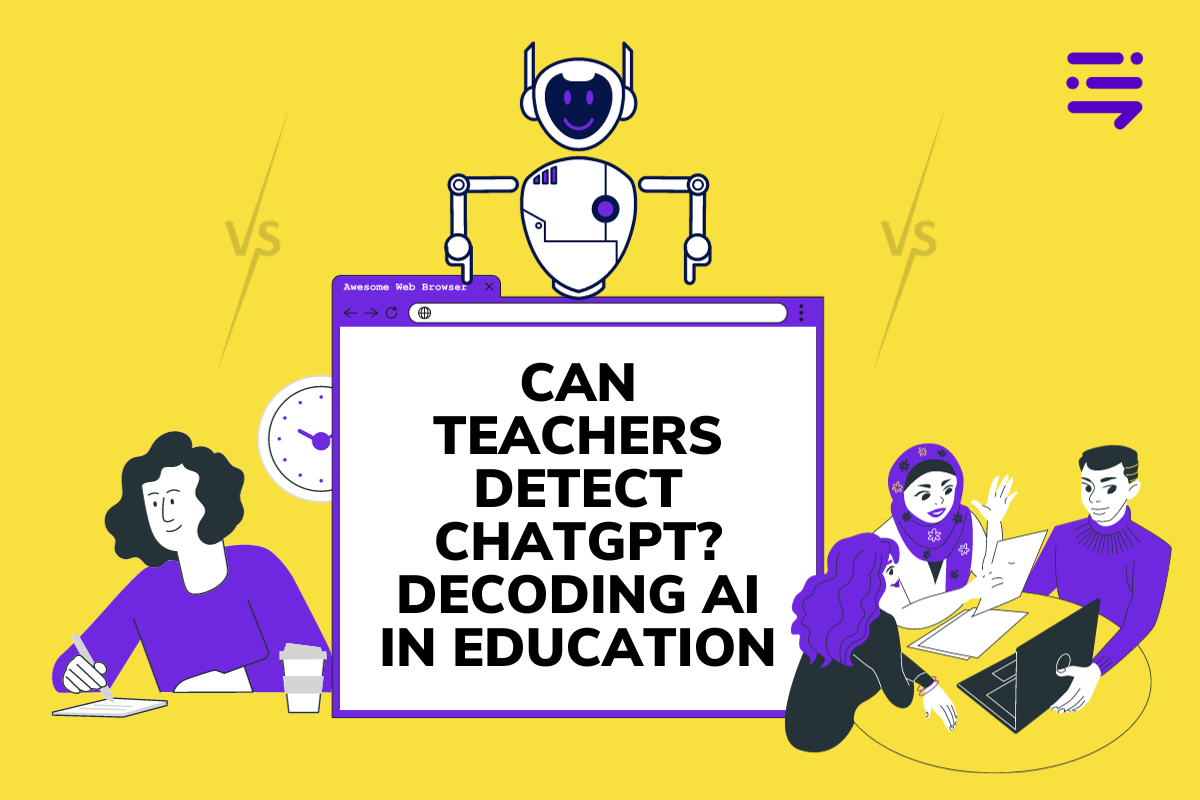Discover top guides, trends, tips and expertise from AIO Writers
Can Teachers Detect ChatGPT? Decoding AI in Education
Julia McCoy
Friday, 27th Oct 2023
The educational landscape has rapidly evolved with the integration of AI-powered chatbots like ChatGPT. This tool has become a hot topic among educators.
While ChatGPT for teachers offers invaluable assistance in boosting student engagement, fostering critical thinking skills, and unburdening instructors, it also raises questions about academic integrity.
Because of this, teachers today need more than red pens; they’re arming themselves with cutting-edge technology to maintain academic integrity.
One burning question on educators’ minds is: Can teachers detect ChatGPT-generated content? Can these tools spot the sophisticated language model of ChatGPT? What happens when AI meets its match in detection software?
In this article, we explore AI technology and how it affects the classroom. Then, we’ll answer the question, “Can teachers detect ChatGPT?” Lastly, we will examine how AI detection software detects AI-written content.
Table of Contents
- Understanding ChatGPT and AI Technology
- Can Teachers Detect ChatGPT?
- FAQs in Relation to Can Teachers Detect Chatgpt
- Conclusion
Understanding ChatGPT and AI Technology
If you’ve been following the tech world, then you may have come across ChatGPT, an artificial intelligence language model created by OpenAI. It’s more than just a cool piece of technology; it’s changing how we interact with machines.
ChatGPT is an AI-powered language model developed to generate human-like text. AI language models are pieces of software that have been trained on enormous amounts of user data to recognize human language patterns and generate coherent sentences that mimic natural speech. For search algorithms and voice prompts, Google and Amazon utilize similar methods.
In simple terms, this AI model takes in prompts given to it and generates text in response. Imagine asking your computer for a weather update or to write a brief summary of Shakespeare’s Hamlet and receiving detailed answers – that’s the power of ChatGPT.

“Write a brief summary of Shakespeare’s Hamlet.”
However, its capabilities go far beyond answering questions or generating summaries. This versatile tool can be used for writing prompts or generating code, among other tasks.

“Write code to read and print duplicate records from the provided CSV file.”
While it excels at understanding and generating text, its capabilities also bring challenges related to academic honesty. In educational institutions, maintaining the integrity of assignments and exams is paramount. From high school essays to college research papers and professional reports, authenticity is key.
Teachers play a vital role in upholding these standards and ensuring that students genuinely learn and demonstrate their knowledge.
Can Teachers Detect ChatGPT?
The question “Can teachers detect ChatGPT?” has crossed the mind of every high school and college student who wants to use AI to ease their workload — especially as AI technology like ChatGPT becomes more prevalent in our day-to-day lives.
So, what’s the answer?
To put it simply, it’s complicated. Detecting ChatGPT-generated content is not always straightforward, but it’s not impossible.
Teachers and educators often find themselves on the frontlines of this challenge. So, they rely on their experience and intuition to identify inconsistencies in student work to detect AI-generated content. This skill can help them spot when a piece of writing may have been generated by AI rather than crafted by the student.
In other words, many teachers don’t need fancy AI detection software to spot AI writing — they can detect it with the naked eye.
For instance, high school teachers might notice a sudden jump in the quality of a student’s work or a sudden shift in writing style. Teachers who are familiar with their students’ abilities can spot deviations in writing style or knowledge.
ChatGPT may lack depth in specific subjects, leading to inconsistencies in terminology and language use. Also, ChatGPT often produces generic responses without a personal touch, which can stand out in assignments requiring personalization.
Analyzing textual elements for recurring patterns is another effective method used by teachers, especially in college. Certain phrases or words repeatedly used throughout assignments are a red flag.
In addition to their own expertise, educators also have access to tools designed specifically for plagiarism and cheating detection at universities – some are even capable of detecting content produced by language models like ChatGPT.
Role of Plagiarism Detection Tools
AI Detection software plays a crucial role in upholding academic honesty and safety. The safety implications that could result from a world where ChatGPT-produced thesis papers are published could certainly result in some dangerous outcomes.
Educators can identify ChatGPT essays or assignments using an AI detector to evaluate the authenticity and efficacy of content up to a certain human standard.
For instance, BrandWell’s AI Detector can spot deviations in language patterns and terminology used, alerting teachers to potential AI-generated content. Additionally, it can compare a student’s writing style with known AI patterns, making it a valuable ally in identifying AI-generated assignments.
Here’s an example of ChatGPT-written text flagged by BrandWell:

BrandWell detects AI using machine learning algorithms to compare the submitted document against millions of other documents from various sources, including books, articles, and internet pages.
While this is impressive, it also means that while AI detection tools are becoming more sophisticated and better at detecting content produced by language models like Chat GPT, they aren’t perfect.
In this age of advanced technology, plagiarism detection tools are indispensable aids for teachers in their ongoing battle against academic dishonesty, ensuring that genuine student learning remains at the core of education.
FAQs – Can Teachers Detect Chatgpt
Is ChatGPT detectable?
Yes, it can be detected. People like educators, teachers, professors, and writers have the ability to spot AI-written text using only their experience, intuition, and skills with the English language. On top of that, universities, businesses, organizations, and schools can detect Chatgpt with AI detection software, like BrandWell’s AI Detector.
How do I use ChatGPT without being detected?
The best way is by not using it for assignments or tests where original work is required. It’s important to maintain academic integrity and honesty.
Conclusion
Can teachers detect ChatGPT? The answer is not as straightforward as you might think.
While detecting ChatGPT-generated content poses challenges, teachers at all levels – from high schools to colleges and professions – continue to strive to maintain academic integrity. That means they’re committed to making sure students are using AI technology ethically.
The rise of AI-written text presents challenges but also opens up exciting avenues for technology-enhanced learning processes. Remember, though – academic integrity matters more than ever!

UNLOCK YOUR POTENTIAL
Long Headline that highlights Value Proposition of Lead Magnet
Grab a front row seat to our video masterclasses, interviews, case studies, tutorials, and guides.



